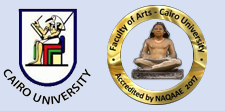عنوان المقال عربي
قَصْدِيَّةُ النص في خِطَابات السلطان هيثم بن طارق: دراسة وفق النظرية التداولية
Document Type
Original Study
Subject Area
Language and Literature
Keywords English
Sultan Haitham bin Tariq، Intentionality، pragmatic، Oman
كلمات مفتاحية عربي
السلطان هيثم بن طارق، القصدية، التداولية، سلطنة عُمان
Abstract English
This study aims to analyze the Intentionality of the text in Sultan Haitham’s speeches that draws the features of Oman through the visions and ideas it contains that require community partnership towards a constructive process that completes the renaissance initiated by The Late Sultan Qaboos bin Said. The problem of the study lies in the fact that despite the moral, cognitive and value of the speeches of Sultan Haitham, they didn’t receive ample attention from researchers to reveal their semantic levels and the intent of the text that were included in the linguistic employment within the context of these speeches. In addition, the extent to which the context and circumstances of the speech influence the choice of verb tenses, and the relationship of the context to the time duration and the number of words in each sultan’s speech. The researchers chose the pragmatic theory as an approach in this study. The study concluded that there is consistency between the linguistic lexicon utilized and the intent and conditions of the speech, and the consistency of the time duration of the speech with the communicative message that that the text creator seeks to give. Also there is an impact of the discourse context on the choice of verb tenses, and present tense verbs formed a remarkable presence in contexts that talk about the process of building Oman and future plans, and imperative verbs did not appear in Sultan Haitham’s speeches except in one Qur’anic verse.
الملخص العربي
هَدَفتْ هذه الدراسة إلى تحليل قَصدِيَّة النَّص في خِطابات جلالة السلطان "هيثم بن طارق" التي ترسم مسارًا جَليًّا لملامح عُمان بما تتضمَّنه من رؤى وأفكار تستوجب الشراكة المجتمعية نحو مسيرة بناءٍ تستكمل النهضة التي بدأها السلطان قابوس بن سعيد طيّب الله ثراه. وتكمن إشكالية الدراسة في أنه رغم القيمة المعنوية والمعرفية لخطابات السلطان هيثم؛ لكنها لم تحظَ بعناية الدارسين للكشف عن قصدية النص التي تضمَّنها التوظيف اللغوي في سياق الخطابات السامية، ولا يتمكن المتلقي من إدراك مضامينها، وتعرُّف عُمْق الدلالات التي يحملها كلُّ جزءٍ من الخطاب، ومدى تأثير سياق الخطاب وظروفه في اختيار أزمنة الأفعال، وعلاقة سياق الخطاب وظروفه بالمدة الزمنية وعدد المفردات في كل خطاب سلطاني. واعتمدتْ الدراسة النظرية التداولية مَنهجًا؛ إذ تُركز على الجانب الضمني للخطاب، وقصدية المتكلم، ومدى تأثير الأفعال في المتلقي المُمثَّل في المجتمع العماني، ثم رصد إحصائي للأفعال المُتكررة في الخطاب. وخَلصتْ الدراسة إلى أن هناك مواءمة بين المُعجم اللغوي المُوظَّف في السياق مع قصدية الخطاب وظروفه، ووجود اتساق بين المدة الزمنية للخطاب والرسالة التواصلية التي سعى مُنْتج النص لإيصالها، وأيضًا هناك أثرٌ لسياق الخطاب وظروفه في اختيار أزمنة الأفعال، فقد شكَّلتْ الأفعال المضارعة حضورًا لافتًا في السياقات التي تتحدث عن مسيرة بناء عُمان والخطط المستقبلية، ولم تَردْ أفعال الأمر في خطابات السلطان هيثم إلا في آية قرآنية واحدة.
Recommended Citation
Al Ghusaini, Zahir Badar and Al Hasani, Tasneem Hamed
(2024)
"Intentionality of the text in Sultan´s Haitham bin Tariq speeches: A pragmatic theory study,"
Journal of the Faculty of Arts (JFA): Vol. 84:
Iss.
1, Article 13.
DOI: 10.21608/jarts.2023.244223.1413
Available at:
https://jfa.cu.edu.eg/journal/vol84/iss1/13
Digital Object Identifier (DOI)
10.21608/jarts.2023.244223.1413
Accept Date
2023-11-20
Publication Date
1-1-2024

